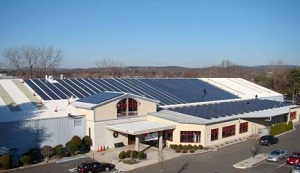Solar energy news recap
 It was a big news week for solar contests last week. While some of it was good news, some of the news was a little more frustrating for solar advocates.
It was a big news week for solar contests last week. While some of it was good news, some of the news was a little more frustrating for solar advocates.
Perhaps the biggest, most frustrating news in the world of solar was the announcement that the Department of Energy’s iconic Solar Decathlon won’t take place on the National Mall this year, upsetting decathlon challengers and solar supporters.
In other solar contest news, the Renewable Energy Initiative launched its Renewable Energy Future TV commercial contest for film and journalism students. Students will produce 30-second commercials related to clean energy investment options. The winner will receive $2,500 and will test drive Tesla Motors’ all-electric Roadster sportscar. General Electric announced the second round of its ecomagination challenge. This time it’s called, “ecomagination Challenge: Powering Your Home.” GE will award $100,000 to each of five winners.
It’s not like other areas of the solar market slowed down last week, however. In fact, one report that came out last week is assuaging solar investors’ fears that the German solar industry would grind to a near halt. Investors had feared Germany would again sharply reduce its feed-in tariff, following a similar move last year, but now it appears that will not happen. Other news shows that the time to invest in solar is now, and companies and industry experts are predicting a banner year for the industry in 2011.
By now you’ve probably heard solar power plants referred to as farms. And at least two pieces of news last week are perfect examples. Perdue Farms, one of the largest poultry suppliers on the East coast announced that it would put a total 1.7 megawatts of solar at two locations. Meanwhile California’s Prime Time Produce said it is installing a 285 kilowatt solar array at its bell pepper packing plant in Coachella Valley. The plant is expected to supply almost all the plant’s electricity during peak season, and more electricity than needed during the off-season.
One segment of the solar industry, the concentrated solar power, has come under increasing fire as of late. The fire has come in the form of delayed, large-scale projects and lawsuits, which protest the location of such installations. However, they still hold promise as one of the least expensive means of providing power. As such, Nur-MOH announced last week that it would install a 38 megawatt solar concentrating power plant on the island of Crete using BrightSource technologies.
There was also some nifty gadget news last week, as Apple received its first patents for solar device integration. If it receives more patents, the next big buzz surrounding the company might just be a new line of solar-powered devices. So you might be freed up from the outlet when you get your next lovely piece of technological wanderlust.
In other solar technology news, fool’s gold might finally become more valuable. This product, now tossed aside as waste from mining, is again being looked at as a possible, inexpensive alternative to silicon in photovoltaics.
While California remains the top state for the solar market, other states are cropping in. Perhaps none as much as Colorado, which has the second-highest renewable energy standard in the country—behind California. The state is moving forward aggressively on renewable energy. Last week, industry leaders met in Denver to discuss energy policy in Colorado—including establishing a solar feed-in tariff in Colorado—and on the national level. The meeting, you could say, is a precursor to the Colorado Solar Energy Industries Association’s solar conference and expo, which will be held in February at the Loveland Embassy Suits Conference Center.
The solar industry is likely to be as busy as we head into the fourth full week of 2011 and beyond.
Image courtesy of Solar Connecticut, a nonprofit solar organization.



